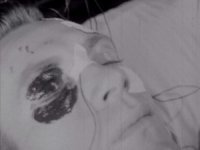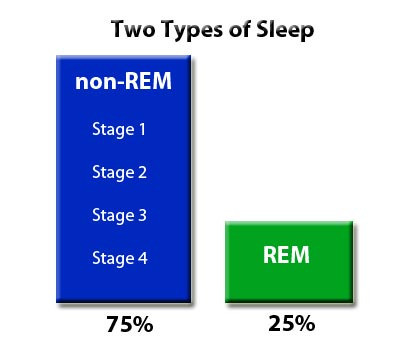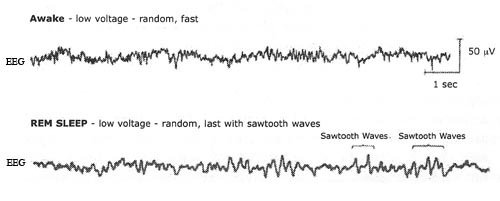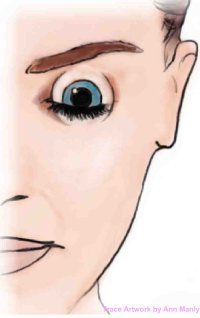
| Connect & Subscribe |
REM Sleep - Exploring A Fascinating Sleep State
Written by Carl DeGuzman, Spring 2010, and Kevin Morton with adaptations from the Stanford Sleep Book
"A highly active brain in a paralyzed body."
"In the small hours of one morning, I was awakened by cries of horror from Louis. Thinking he had a nightmare, I woke him. He said angrily, 'Why did you wake me? I was dreaming a fine bogey tale.' I had awakened him at the first transformation scene ..."
Table Of Contents

All of us have dreams of one sort or another, and even though they may not lead to us becoming famous authors (or even be very easy to remember for that matter), most of our vivid dreaming happens during periods of the night while we are in the state of REM sleep.
Our professor, Dr. Dement, helped discover the presence of REM sleep and its connection to dreaming in 1952, with fellow PhD student Eugene Aserinsky and their adviser, Nathaniel Kleitman.

Interesting Stuff! - Oil On The Eye
 One of the earliest REM sleep observations. Sorry for the mess!
One of the earliest REM sleep observations. Sorry for the mess!
When REM sleep was first being studied, it was suggested that putting oil over the eyelid would help the researchers see the rapid eye movements. Turns out that the oil was not the least bit necessary and that you could see the eye movements perfectly clear without any added embellishments. Whoops, sorry for the mess!
The Basic REM Sleep Cycle

We alternate between two very different behavioral states while we sleep, REM (rapid eye movement) sleep and non-REM sleep. Non-REM sleep tends to take up about 75% of the time we spend asleep, while REM sleep takes up the other 25% and begins around 90 minutes after we fall asleep. As the night progresses the REM periods we experience get increasingly longer and by the time we come to our fourth of fifth REM period, we stay in REM sleep for about 30-45 minutes. You can get a better picture of the REM sleep cycle with visual aids here.
While both states have a few characteristics in common, such as a lack of perceptual awareness to the outside world and a general absence of body movement, the differences between the two are quite defined. Non-REM is divided into four distinct stages with brain wave patterns that are completely different than those in REM sleep. You can learn more about non-REM and its stages here.
Characteristics of REM Sleep
Dr. D's Sleep Book Says...
"The simplest definition of REM sleep is a highly active brain in a paralyzed body."
If after reading this article you remember nothing else about REM except for the above sentence, you've actually done fairly well for yourself. Those two things, an active brain and a paralyzed body, are the key characteristics of the state.
An Active Brain
Brain activity during REM sleep is amazingly very comparable to our brain activity during wakefulness. Different parts of the brain show different levels of activity, some parts more active during REM and some parts less, but the overall picture is that the brain in REM sleep is highly active.
Seeing as REM is the part of the night that dreaming occurs, this makes sense intuitively. In waking life the brain perceives and reacts to the world around us. During dreaming the brain is not only perceiving and reacting, but also creating the vivid environment in which the dream takes place. And this calls for a lot of brain power, as the EEG recordings show below.
 Brain activity during REM sleep is very comparable to activity during wakefulness, as evidenced in these EEG recordings showing very fast, quick waves in both states.
Brain activity during REM sleep is very comparable to activity during wakefulness, as evidenced in these EEG recordings showing very fast, quick waves in both states.
A fair amount of the brain activity during REM consists of motor outputs--our brains essentially trying to communicate with our bodies about what's going on in the dream world (i.e. There's a monster chasing you! Legs, run!!). Thankfully, most of us don't get up and run out of bed when our brain tells us to or the walls of our bedrooms would likely have some serious dents by now. But why don't we? What stops us from acting out our dreams? That's where the paralysis comes in.
A Paralyzed Body
While the brain is highly active in sending all sorts of motor instruction to the body during REM sleep, a brain mechanism known as REM atonia actively prevents these motor potentials from ever reaching the muscles. REM atonia inhibits the final nerve pathways to the vast majority of muscles, cutting the signals off at the spinal cord.
Only the eye muscles (which are commanded by cranial nerves) and diaphragm (so we can breathe) are exempt from the paralysis. Everything else is effectively paralyzed. This makes it pretty easy to detect REM sleep by looking at an EMG, which measures motor activity in the chin during sleep, because the line goes virtually flat.

Crazy Stuff! - Paralysis Gone Wrong
It's not uncommon for us to become aware of REM paralysis even after we've woken up. Occasionally (and in some people quite commonly), REM atonia will outlast sleep and carry over into wakefulness, creating an alarming situation of being awake but not being able to move for up to a few minutes. Most people will experience this awareness during sleep paralysis (or ASP) at least once in their life. Has it happened to you? Learn more about awareness during sleep paralysis here.
On the flip side of things, instead of working too well, in some individuals REM atonia does not work well enough. In fact, people who suffer from REM sleep behavior disorder (or RBD) actually do act out parts of their dreams, and sometimes in ways that can be really troublesome and even violent. You can learn more about RBD here.
Just when you thought REM atonia couldn't get any more crazy, individuals with narcolepsy experience manifestations of REM atonia intruding into their wakefulness at any time of the day, causing what are known as cataplectic attacks. In serious cataplectic attacks a narcoleptic could go from laughing with friends one second to collapsed on the floor unable to move the next. You can learn more about narcolepsy and its symptoms of cataplexy here.
Rapid Eye Movements

Another important characteristic of REM sleep, as the name suggests, is the presence of binocularly synchronous, rapid eye movements. As mentioned above, the eye muscles are exempt from the paralysis. Interestingly, the eye patterns during REM sleep many times match the visual field movements in the dream world. In other words, your real eyes move to see what you are seeing in the dream world. Wild, huh?!
The Scanning HypothesisThe above is known as the scanning hypothesis, and has been demonstrated to be valid with some pretty awesome studies.
It started with some simple observations of EOG recordings, which measure eye movements during sleep. Researchers once noticed that a dreamer's EOG recordings during REM sleep were far more regular than they normally tend to be. The recordings showed the subject's eyes to be moving directly back and forth continuously at regular intervals. The researchers were intrigued and asked the subject what he had been dreaming. The subject responded he had been at the side of the net watching a ping pong match, and the scanning hypothesis was born!

Cool Stuff! - Dream Time
Dr. Stephen LaBerge, the world's foremost expert on lucid dreaming and a regular guest lecturer at Stanford Sleep and Dreams, put the scanning hypothesis to use in an ingeniously designed study in 1985 that attempted to figure out how dream time matched up with time in the waking world.
To accomplish the task Dr. LaBerge called on the assistance of some highly skilled lucid dreamers (a lucid dream entails gaining consciousness within your own dream. Skilled lucid dreamers can then use this consciousness to control what happens in the dream). The lucid dreamers were first asked to estimate 10 seconds while awake. People in general tend to underestimate this count, reaching 10 a little faster than we should (even using the ol' faithful Mississippi technique!). The lucid dreamers ended up at something like 8.7 seconds.
Then, once he had these numbers Dr. LaBerge and the dreamers devised a series of signals that they would use to communicate with each other while the dreamers were in the midst of their dream. For instance, when the dreamer first became lucid he would move his line of sight left, right, and left. This signal would show up on Dr. LaBerge's EOG recordings to be examined during the dream or afterwards. (Think about this! Consciously communicating with the waking world while dreaming! Amazing, huh?)
Once the dreamer was lucid, he would eventually remember the task at hand--to count to 10, estimating 10 seconds in the dream world. The dreamer gave another eye signal--left, right, left, right--to communicate that he was starting to count, and then one final eye signal to communicate that he had reached 10--left, right, left, right.
Sure enough, when Dr. LaBerge examined the EOG recordings the first eye movement signaling the start of counting and the second eye movement signaling the end were--you guessed it--about 8.7 seconds apart. It appears that time in the dream world moves at the same speed as time in the waking world.
If you saw the movie Inception (which was awesome!), this means that one of the central elements the story operates on--time progressing exponentially slower at deeper dream levels--is not quite right.
Is Either REM Sleep Or NREM Sleep More Restorative Than The Other?
The jury is still out on this one. While studies involving REM sleep deprivation have shown that the body can fall into REM more quickly after being deprived from it for a time, suggesting that it is necessary for the body, there is no conclusive evidence as of yet as to whether either state is inherently more restorative.
Wrap Up
REM sleep is definitely one of the most interesting aspects of our existence. When the brain can function without any limitations of the physical world, literally anything imaginable is possible. Unfortunately, there are also very serious disorders related to REM sleep which we will hopefully learn more about and discover increasingly affective treatments for.
Hopefully someday we will also be able to determine the purpose of REM sleep, which right now is a cause of much speculation but few concrete answers. Sleep research is a blossoming field, and as we move into the future we will continue to accumulate more and more knowledge on the subject.
And join the conversation with your own comments here:
blog comments powered by DisqusAbout This Site
Welcome! This site is continuously being created by students of Dr. William C. Dement's Sleep And Dreams course at Stanford University.
We made this site as a call to action for people all over the world to live healthier, happier, safer, and more productive lives by learning about their own sleep. We have faith that reading the information provided on this site will motivate you to be smart about your sleep deprivation and strategic about your alertness in order to live life to your fullest, most energetic potential.
In fact, we challenge you to do so! What do you say, are you up for the challenge?
Interviews With Sleep Specialists: Insights Into the Worlds of Sleep Medicine & Sleep Business
America's Most Dangerous Disorder: What Is Sleep Apnea Doing To Your Sleep?
Sleep Debt: How Much More Will You Achieve When You Reduce Yours?
The Stages Of Sleep: The Journey Through The Night
Delayed Sleep Phase: You Want To Sleep But You're Not Tired Yet
Paralyzed at Night: Is Sleep Paralysis Normal?
Sleep In Words: Smart, Strange, and Funny Quotes About Sleep
Sleep Disorders In Children: What's Keeping Your Child From A Full Night's Rest?
Attacks of Pavor Nocturnus (a.k.a. Sleep Terrors, Night Terrors, or Incubus Attacks)
The Stanford Sleep Book
Dr. Dement's pioneering textbook has been the core text for Sleep and Dreams since 1980, but it has just recently been made available to the wider public for the first time.
In it you'll find a more detailed account of the most important things you need to know about sleep, alertness, dreams, and sleep disorders. Studies, statistics, plus plenty of Dr. Dement's classic anecdotes painting the history of sleep medicine.
Preface | Intro | Contents | Get A Copy
More Sleep Resources
The Zeo
A revolution in personal sleep tracking, the Zeo is a wireless headband that transmits your brainwaves in realtime to a dock (pictured here) or your smartphone. The result? You can wake up and see exactly what stages of sleep you were in during the night! Unprecedented personalized sleep knowledge.
Sleep Paralysis: A Dreamer's Guide
Ever woken up paralyzed? A surprising number of us have, believe it or not. But few know the actual causes of this phenomenon, and fewer still how to exert control over it. Dream researcher and sleep paralysis expert Ryan Hurd shares breakthrough insights into how to do just that.
Important Disclaimer
Please Note:
The information found on this page and throughout this site is intended for general information purposes only. While it may prove useful and empowering, it is NOT intended as a substitute for the expertise and judgments of healthcare practitioners.
For more info, see our
Terms of Use.










